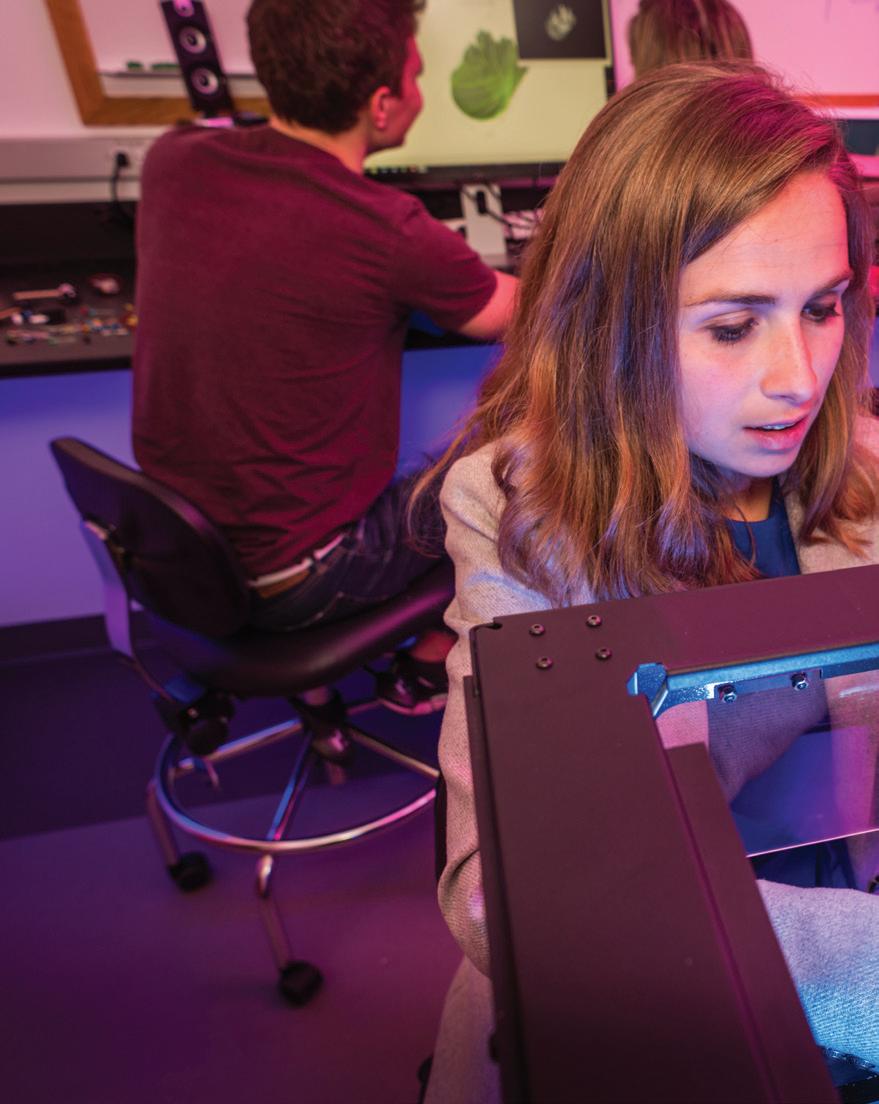
13 minute read
Discovery
Teaching and Learning discovery
HARVARD PROGRAM IN THERAPEUTIC SCIENCE
Advertisement
New Science for Better Medicines The Harvard Program in Therapeutic Science (HiTS) and its flagship Laboratory of Systems Pharmacology (LSP) use laboratory-based experiments, computer science and molecular medicine to advance drug discovery and precision medicine. HiTS trains pre- and postdoctoral students to be leaders in drug discovery and builds partnerships with hospitals to test new theories. Directed by Peter Sorger, the Otto Krayer Professor of Systems Pharmacology, the LSP is focusing on the beneficial and adverse effects of cancer drugs and on new ways to developing therapies for complex and incurable diseases such as Alzheimer’s disease. In 2016, HiTS launched its Program in Regulatory Science and established the Henri and Belinda Termeer Early Career Investigator Fellowship jointly with Massachusetts General Hospital. Funded by a $5 million gift from the Termeers, this program supports a home in the LSP for a clinician-scientist and accelerates the application of systems pharmacology concepts to clinical trials and patient care.
Dean’s Report 2016–2017
RESEARCH HIGHLIGHTS
Strength of Purpose
HMS has a unique ability to convene multiple research communities around innovative discovery strategies, creating the potential to relieve human suffering in powerful new ways. Within Harvard, for example, a partnership with the Department of Stem Cell and Regenerative Biology, which exists within the University’s Faculty of Arts and Sciences, was established in 2007, making it one of the first cross-departmental collaborations in the University’s history.
Selected HMS achievements in 2016 Sponsored research The combined research efforts of HMS and the Harvard School of Dental Medicine resulted in $238,463,884 in new awards for sponsored research programs at HMS and HSDM, which included $186,713,836 in federal grants. Of those grants, $171,846,734 was awarded by the National Institutes of Health. Research administration HMS completed the consolidation of research operations within one centralized office, resulting in School-wide efficiencies. The Research Administration and Operations office now oversees the Harvard Center for Comparative Medicine, which manages animal facilities; the Office of the Institutional Animal Care and Use Committee; the Committee on Microbiological Safety; and the Sponsored Programs Administration, previously under the Office of Finance, which provides pre- and post-award support for sponsored projects. The Harvard T.H. Chan School of Public Health provides administrative oversight and support for the Institutional Review Board for HMS, HSDM and the Harvard Chan School. IT infrastructure Biomedical science is data-driven and requires customized software, multiple storage platforms and accelerated capacity for processing vast amounts of data, particularly in fields such as bioinformatics and genetics. The Office of Information Technology implemented new data management solutions and broadened IT highways on the Quad by upgrading the HMS network and increasing wireless capacity, benefiting both the research and educational communities.
Technology development Harvard’s Office of Technology Development (OTD) continues to engage and support HMS faculty in advancing research toward the clinic through productive industry collaborations and gap funding from the Blavatnik Biomedical Accelerator. OTD has promoted entrepreneurship and innovation at HMS through networking events such as the Guppy Tank, Pathways to Entrepreneurship and the Biomedical Informatics Entrepreneurs Salon. It also has established a new entrepreneur-in-residence program in the Department of Biomedical Informatics. In 2016, OTD launched 13 new startup companies and granted 52 new licenses to develop and commercialize Harvard technologies.
HARVARD CATALYST
Catalyzing Locally, Sharing Nationally
Founded in 2008 with the largest NIH Clinical and Translational Science Award (CTSA) granted, and funded again in 2013, Harvard Catalyst | The Harvard Clinical and Translational Science Center connects, convenes and catalyzes Harvard faculty and trainees, accelerating research while training the next generation of clinical and translational investigators. Directed by Lee Nadler, the Virginia and D.K. Ludwig Professor of Medicine and dean for clinical and translational research, Harvard Catalyst, among its many achievements, has awarded more than $14 million in pilot awards to new teams of investigators; educated more than 4,000 junior faculty on the foundations of clinical and translational research, as well as on advanced topics such as medical device development, network medicine and biomarker development; and provided study design assistance, project management and regulatory guidance on more than 1,500 clinical protocols.
As a facilitator of Harvard multi-investigator research, Harvard Catalyst leads the Football Players Health Study at Harvard University and has enabled the creation of the Scalable Collaborative Infrastructure for a Learning Health System network, which is funded by the Patient-Centered Outcomes Research Institute, and the BostonBiomedical Innovation Center, which is funded by the National Heart, Lung and Blood Institute. In 2015, Harvard Catalyst was awarded a Massachusetts Department
Opposite page: Rachel Warden, lab automation specialist, operates the Epson 6-axis robot arm paired with the Cartesian (linear) robot. Custom designed and built at the ICCB-Longwood Screening Facility, these robots are used by HMS investigators to perform highthroughput screens of chemical libraries.
of Public Health contract to evaluate the Commonwealth’s $60 million Prevention Wellness Trust Fund.
As one of the 64 members of the CTSA Consortium, Harvard Catalyst leads several national initiatives to accelerate clinical research, including SMART IRB, a platform to implement the new NIH Single IRB policy for multisite studies. SMART IRB evolved largely from the Harvard Master Reciprocal Common IRB Reliance Agreement, which was developed to accelerate IRB approval of studies conducted at more than one Harvard site. The Shared Health Research Information Network (SHRINE) connects clinical data warehouses at dozens of CTSA sites to access research information about millions of patients. Profiles, a web tool that provides real-time information about faculty and trainees and enables collaboration, has been adopted by more than 30 institutions globally. Eagle-i, a biomedical search engine, helps researchers locate any of 101,000 resources at Harvard and 42 other participating institutions.
BIOLOGICAL CHEMISTRY AND MOLECULAR PHARMACOLOGY
Revealing the Structure of an Elusive Receptor
The human sigma-1 receptor is an enigmatic cellular protein implicated in diseases ranging from cancer to amyotrophic lateral sclerosis (ALS). Despite more than 40 years of research, the molecular details of the sigma-1 receptor and its activity have remained elusive. Work in the lab of Andrew Kruse, assistant professor of biological chemistry and molecular pharmacology, has revealed the molecular structure of the sigma-1 receptor for the first time, showing the architecture of this unusual protein. As reported in Nature, the molecular structure is composed of three receptor molecules in a triangular arrangement, each bound to a drug-like inhibitor. These findings open the door to further exploration of the molecular basis for sigma-1 function and its potential as a therapeutic target for ALS and other diseases.
BIOMEDICAL INFORMATICS
A Natural History of Neurons
Inherited mutations have been implicated in brain diseases and disorders, but the role of noninherited mutations has been murkier.
20 Dean’s Report 2016–2017 I DISCOVERY
A discovery made by pairing single-cell genome sequencing with rigorous data analysis lays the foundation for investigations into whether noninherited mutations contribute to neurodevelopmental and neurodegenerative diseases. The study, published in Science by Peter Park, associate professor of biomedical informatics, and Christopher A. Walsh, the HMS Bullard Professor of Pediatrics and Neurology at Boston Children’s Hospital, demonstrated for the first time that a large number of somatic (noninherited) mutations are present in the brain cells of healthy people. The researchers showed that somatic mutations occur more often in the genes that neurons use most. They also demonstrated that it is possible to trace cell lineages based on mutation patterns, which may lead to decoding the brain’s pattern of development.
CELL BIOLOGY
Facebook for the Proteome
The mapping of the 20,000 genes in the human genome was completed in 2003, but until recently, only a small fraction of proteins produced by these genes were known. Now a proteomics method developed by Wade Harper, the Bert and Natalie Vallee Professor of Molecular Pathology and chair of cell biology, and Steven Gygi, professor of cell biology and director of the Thermo Fisher Center for Multiplexed Proteomics at HMS, has streamlined the mapping of all protein complexes in the human proteome. As published in Cell, the researchers combined high-throughput affinity purification with mass spectrometry to create a publicly available resource called the BioPlex network, which identifies nearly 24,000 interactions among more than 7,600 proteins—86 percent previously unknown. As scientists add to this web-based network, which predicts where proteins are located within cells, they hope that protein interactions and influences on health and disease will be revealed.
GENETICS
Biological Origin of Schizophrenia
Based on genetic analyses of nearly 65,000 people, molecular analyses of brain tissue from 500 people, and new genetic methods developed by an HMS graduate student, HMS researchers discovered that the risk of schizophrenia increases if a person inherits overactive variants in a gene that stimulates synaptic pruning, the process whereby connections between neurons are eliminated. The study, published in Nature, was led by Steven McCarroll, associate professor of genetics and director of genetics for the Stanley Center at the Broad Institute of Harvard and MIT. It is the first time schizophrenia’s origin has been linked conclusively to specific gene variants and a biological process. It also helps explain two decades-old observations: that synaptic pruning is particularly active during adolescence, when symptoms of schizophrenia typically develop, and that the brains of individuals affected with schizophrenia tend to show fewer connections between neurons. These findings may lead to future therapies directed at the disorder’s roots, rather than just its symptoms.
GLOBAL HEALTH AND SOCIAL MEDICINE
Charting a Course to Zero TB Deaths
Tuberculosis has been curable and preventable since the 1950s, but more than 1.5 million people each year still die from this airborne disease. In a series published in The Lancet, Salmaan Keshavjee, associate professor of global health and social medicine, and colleagues in GHSM detailed scientific and therapeutic policies to rapidly stop TB deaths and change the epidemic’s course one community at a time—an effort called the Zero TB Cities Initiative. Rather than follow current practices that often target only the sickest patients and provide incomplete therapies, the TB elimination plan deploys methods such as targeting hot spots of transmission, identifying infected individuals before they can transmit disease to others, treating those infected with TB before they develop active disease, and delivering prompt and proper treatment for all forms of tuberculosis.

A high-throughput liquid handler transfers reagents to 384 experimental wells simultaneously. More than 500,000 small molecules and several RNAi libraries are available for screening at ICCBLongwood, and the screening collections are continuously growing. HEALTH CARE POLICY
Payment Reform Achieves Early Gains
Accountable care organizations (ACOs), groups of health care providers who provide care to a population of patients under a global budget tied to performance benchmarks, are achieving early success. ACOs that joined the Medicare Shared Savings Program (MSSP) when it launched in 2012 achieved modest savings while maintaining or improving performance on measures of quality of patient care in 2013, the program’s first full year. These findings, published in the New England Journal of Medicine, emerged from a study led by J. Michael McWilliams, the Warren Alpert Foundation Associate Professor of Health Care Policy. Compared with non-ACO providers in the same areas, ACOs that were early adopters of MSSP lowered spending by 1.4 percent in 2013, a $238 million reduction.
MICROBIOLOGY AND IMMUNOBIOLOGY
Microbial Symbiosis Constrains Intestinal Inflammation
Immune system cells, called T regulatory cells, that express the transcription factor Foxp3, are known to promote tissue homeostasis, or equilibrium, in several settings. As reported in Science, HMS researchers found a broad but specific array of individual bacterial species in the human gut that work together in the mouse colon to constrain immuno-inflammatory responses by symbiotically giving rise to a distinct population of T regulatory cells. The induction of these T cells in the colon requires the transcription factor Rory, which is a paradox because in other tissues Rory antagonizes Foxp3. The investigative team, led by Christophe Benoist and Diane Mathis, both the Morton Grove-Rasmussen Professors of Immunohematology, and Dennis Kasper, the
EDUCATION I Dean’s Report 2016–2017
HMS William Ellery Channing Professor of Medicine at Brigham and Women’s Hospital, showed that Rory acts differently in the colon, demonstrating how the activity of microbes can influence different characteristics of immune cells.
NEUROBIOLOGY
Odor Alternative
HMS researchers have discovered a new mechanism for how the nose detects smells. For more than 25 years, research has shown that smells are detected via pathways triggered by seven-transmembrane G-protein coupled receptors (GPCRs). Only one type of GPCR is expressed per sensory neuron in the nose, which enables the brain to distinguish different smells. But a team led by Sandeep Datta, assistant professor of neurobiology, has uncovered an alternative method by which some odors are sensed. Findings published in Cell reveal that a system known as the “olfactory necklace” does not use GPCRs but instead uses a new family of proteins that act as smell detectors. Rather than discriminating between odors, these necklace receptors may instead detect a variety of odors that trigger innate behaviors, perhaps working as a mammalian alert system.
STEM CELL AND REGENERATIVE BIOLOGY
Making Bone Marrow Transplants Safer
HMS scientists have taken the first steps toward making bone-marrow transplantation safer and more widely available for millions of people with AIDS and blood disorders such as sickle cell anemia and thalassemia. Transplantation currently is the only curative therapy, but for the new transplanted stem cells to do their work, the faulty stem cells must be killed first by using damaging chemotherapy or radiation. As reported in Nature Biotechnology, a team led by David Scadden, professor of stem cell and regenerative biology and chair of the department, and co-director of the Harvard Stem Cell Institute, developed a procedure using specific antibodies that successfully removes more than 98 percent of blood stem cells in lab animals, making it as effective as chemotherapy and radiation but without collateral damage. The scientists are now working to identify antibodies effective in humans.
FOR MORE ON DISCOVERY hms.harvard.edu/research

Cymbals allow composers to add color and emphasis to musical scores. They often provide a resounding closing note. Here, a Longwood Symphony Orchestra percussionist prepares for a key moment in a performance. SYSTEMS BIOLOGY
Hidden in the Code
Knowing the three-dimensional structures of proteins, RNA molecules and other building blocks of the body provides a key to understanding how these molecules work, what goes wrong in disease, and how abnormalities might be fixed. But methods such as X-ray crystallography or nuclear magnetic resonance can take time and money, and for RNA, it’s not even clear which molecules have 3-D shapes or definable functions. Adapting a tool previously developed to predict portions of protein structures using only their amino acid sequences, researchers led by Debora Marks, assistant professor of systems biology, did the same for RNA molecules. Published in Cell, these findings promise to help researchers determine which of the hundreds of thousands of as-yet unstudied RNAs serve useful functions in the body.
HARVARD SCHOOL OF DENTAL MEDICINE
Redefining Renal Phosphate Handling
The body must maintain normal phosphate levels or serious health consequences can arise, especially among patients with chronic kidney disease. To maintain normal levels of phosphate in the body, bones produce fibroblast growth factor 23 (FGF23), which signals the kidneys to excrete phosphate. FGF23 acts only in the presence of Klotho, a protein primarily expressed in the kidneys’ distal tubules where it regulates calcium. Klotho also is present in low levels in renal proximal tubules, but its role there has been unclear. As reported in Kidney International, a study led by Beate Lanske, professor of oral medicine, infection and immunity at HSDM, described for the first time that Klotho expression in the proximal tubules of transgenic mice has a limited but definite role in regulating phosphate. This work opens new pathways for exploring the interplay between distal and proximal tubules in controlling mineral homeostasis. n







